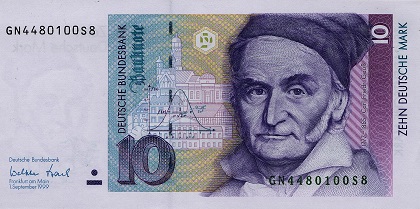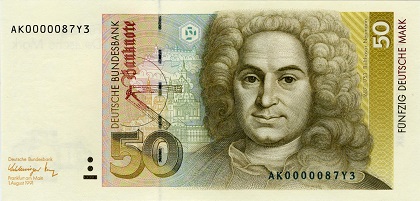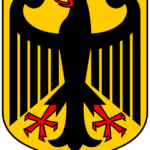 At the core of Germany’s success and influence lies its currency. The deutsche mark gave concrete expression to West Germany’s international financial and economic success and also contributed to it. Since unification, it has become even more important as a symbol as well as an instrument of Germany’s new central role in Europe. The success of the deutsche mark has been anchored in the success of West German exports, in the Bundesbank’s solicitous management of the currency’s value, and in the confidence generated by the country’s prosperity.
At the core of Germany’s success and influence lies its currency. The deutsche mark gave concrete expression to West Germany’s international financial and economic success and also contributed to it. Since unification, it has become even more important as a symbol as well as an instrument of Germany’s new central role in Europe. The success of the deutsche mark has been anchored in the success of West German exports, in the Bundesbank’s solicitous management of the currency’s value, and in the confidence generated by the country’s prosperity.
The deutsche mark has been a model of stability since it became fully convertible in 1958. No other major currency, including the Japanese yen or the Swiss franc, has been stronger. The United States dollar, the cornerstone of the global system, has lost about two-thirds of its value against the deutsche mark since 1958.
The deutsche mark has become the second-largest currency component of global monetary reserves, second only to the United States dollar. Less than 10 percent of the world’s monetary reserves were held in deutsche marks throughout most of the 1970s, but the amount rose to 15 percent by the end of 1987. By the end of 1989, around 20 percent of all global monetary reserves were in deutsche marks. The deutsche mark’s position in global monetary reserves largely reflects the extensive deutsche mark holdings in European foreign-exchange reserve accounts as well as the desire among all industrial state treasuries and central banks to hold a stable currency in their reserves. According to the United States Federal Reserve Board, the United States government holds more than US$13 billion of its reserves in deutsche marks, an amount greater than its holdings in Japanese yen.
 The deutsche mark is not used as widely for transactions as it is to supply central-bank reserves. Global commodity prices are still largely denominated in United States dollars. Whatever the deutsche mark’s strengths may be, it does not offer the kind of liquidity that the dollar does. Invoicing in deutsche marks is concentrated on Germany’s own commerce, but almost 15 percent of world trade is conducted on a deutsche mark basis. The deutsche mark figures much less significantly than the dollar in the creation of international credits or in debt servicing. But a growing quantity of international bond issues–including some being floated in the United States–are denominated in deutsche marks. Major United States banks offer deutsche mark accounts for Americans who want to hedge some of their assets against a fall in the dollar. The World Bank has floated Eurodeutsche mark bonds, as have various United States corporations. In Europe the deutsche mark has virtually become a parallel currency, with prices in Western Europe and Eastern Europe increasingly quoted in deutsche marks as well as in local currencies.
The deutsche mark is not used as widely for transactions as it is to supply central-bank reserves. Global commodity prices are still largely denominated in United States dollars. Whatever the deutsche mark’s strengths may be, it does not offer the kind of liquidity that the dollar does. Invoicing in deutsche marks is concentrated on Germany’s own commerce, but almost 15 percent of world trade is conducted on a deutsche mark basis. The deutsche mark figures much less significantly than the dollar in the creation of international credits or in debt servicing. But a growing quantity of international bond issues–including some being floated in the United States–are denominated in deutsche marks. Major United States banks offer deutsche mark accounts for Americans who want to hedge some of their assets against a fall in the dollar. The World Bank has floated Eurodeutsche mark bonds, as have various United States corporations. In Europe the deutsche mark has virtually become a parallel currency, with prices in Western Europe and Eastern Europe increasingly quoted in deutsche marks as well as in local currencies.
Bundesbank officials worry constantly that the growing circulation of the deutsche mark makes it difficult to control the supply of the central bank’s own currency. Deutsche marks held abroad, circulating abroad, and perhaps even used for currency intervention abroad are still part of the total German money supply. Sudden, large flows could have undesirable impacts on German interest rates or German prices, materially complicating the execution of German monetary policy. The bank fears that any decline in the deutsche mark’s value or in the German current-account surplus could set off a selling wave that would force it to intervene massively and perhaps unsuccessfully. Bundesbank president Tietmeyer has warned that the high deutsche mark holdings abroad place a particular burden on the Bundesbank because any loss of faith in the German currency could provoke large-scale selling. The deutsche mark has thus become a burden for Germany as well as a blessing. The Bundesbank stated in May 1991 that one reason it had to maintain high interest rates was to avoid the kind of decline and subsequent market effects that Tietmeyer had cited. The German currency risks finding itself on a treadmill where the stronger it gets, the stronger it must remain until the German monetary authorities no longer dare to reduce interest rates significantly for fear that they might spark a deutsche mark sell-off.
The IMF recognized the reality of German monetary power in 1990, when it promoted Germany and Japan to share the second rank just below the United States and ahead of Britain and France. German government and banking officials were not certain that they welcomed such prominence, but they were prepared to accept it as a reflection of international appreciation of German monetary policies.
 The West German role in the development of the global financial and monetary system has been replete with ironies. No state consistently had a greater interest in developing a stable system and in cooperating in such a system. Nonetheless, West German policy helped undermine and even destroy some of the arrangements that West Germany wanted to maintain. During the Bretton Woods era, pressures on the dollar almost always expressed themselves in massive purchases of deutsche marks. The strength of the deutsche mark weakened the system because any currency–including the United States dollar–could come under attack if it were not defended and preserved as solicitously as the deutsche mark was by Germany. The only currencies and systems that survived this pressure were those whose governments determined from the beginning that they would follow a strict monetary discipline similar to that applied by the Bundesbank to the deutsche mark.
The West German role in the development of the global financial and monetary system has been replete with ironies. No state consistently had a greater interest in developing a stable system and in cooperating in such a system. Nonetheless, West German policy helped undermine and even destroy some of the arrangements that West Germany wanted to maintain. During the Bretton Woods era, pressures on the dollar almost always expressed themselves in massive purchases of deutsche marks. The strength of the deutsche mark weakened the system because any currency–including the United States dollar–could come under attack if it were not defended and preserved as solicitously as the deutsche mark was by Germany. The only currencies and systems that survived this pressure were those whose governments determined from the beginning that they would follow a strict monetary discipline similar to that applied by the Bundesbank to the deutsche mark.
Related articles:
German Economy
The Domestic Economy of Germany
German International Economic Relations
Bundesbank
The Economic Miracle of Germany
Impact of Unification on German Economy
Germany in the World Economy
Culture of German Management







